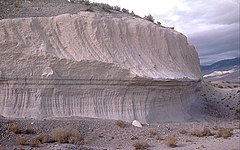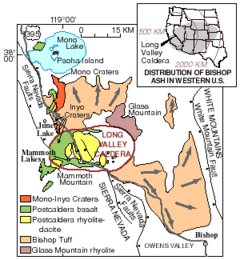Bishop Tuff
| Bishop eruption | |
|---|---|
 Two layers of the Bishop Tuff: lower layer was from ashfall, upper layer was from the main pyroclastic flow. | |
| Volcano | Long Valley Caldera |
| Date | 764,800 ± 600 years ago |
| Type | Ultra-Plinian |
| Location | California, United States 37°43′00″N 118°53′03″W / 37.71667°N 118.88417°WCoordinates: 37°43′00″N 118°53′03″W / 37.71667°N 118.88417°W |
| VEI | 7 |
 Map of the Long Valley Caldera, with Bishop Tuff outlined. | |
The Bishop Tuff is a welded tuff that formed 764,800 ± 600 years ago[1] as a rhyolitic pyroclastic flow during the eruption that created the Long Valley Caldera.[2] Large outcrops of the tuff are located in Inyo and Mono Counties, California, United States. Approximately 200 cubic kilometers of ash and tuff erupted outside the caldera.[3]
Modern exposure[]
The Bishop Tuff caps a volcanic plateau in the northern Owens Valley in eastern California. The tableland formation is located east of U.S. Route 395 and west of the Nevada stateline, sitting northwest of Bishop and southeast of Crowley Lake and Mammoth Lakes. Another part of the flow is south of Mono Lake, and surrounding the Mono-Inyo Craters.
Deposits of Bishop Tuff in this area cover nearly 2,200-square-kilometer (850 sq mi), and range in thickness from 150-meter (490 ft) to 200-meter (660 ft).
The Owens River cuts through the Volcanic Tableland, an ignimbrite plateau that is a principal sector of the Bishop Tuff outflow sheet. Erosion of the plateau by the Owens River has created the Owens River Gorge.[4]
See also[]
References[]
- ^ Andersen, Nathan L.; Jicha, Brian R.; Singer, Brad S.; Hildreth, Wes (2017-11-21). "Incremental heating of Bishop Tuff sanidine reveals preeruptive radiogenic Ar and rapid remobilization from cold storage". Proceedings of the National Academy of Sciences. 114 (47): 12407–12412. Bibcode:2017PNAS..11412407A. doi:10.1073/pnas.1709581114. ISSN 0027-8424. PMC 5703294. PMID 29114056.
- ^ Crowley, J.L.; Schoene, B.; Bowring, S.A. (December 2007). "U-Pb dating of zircon in the Bishop Tuff at the millennial scale". Geology. 35 (12): 1123–1126. Bibcode:2007Geo....35.1123C. doi:10.1130/G24017A.1.
- ^ "Bishop Tuff in Long Valley Caldera, California". Long Valley Caldera. USGS. Retrieved 2021-12-06.
- ^ Hildreth, Wes; Fierstein, Judy (2016). "Long Valley Caldera Lake and Reincision of Owens River Gorge". Scientific Investigations Report. United States Geological Survey: 2. ISSN 2328-031X.
External links[]
| Wikimedia Commons has media related to: Long Valley Caldera#Bishop Tuff (category) |
- Tuff formations
- Pyroclastic plateaus
- Volcanism of California
- Geologic formations of California
- Geology of Inyo County, California
- Landforms of Inyo County, California
- Landforms of Mono County, California
- Inyo National Forest
- VEI-7 eruptions
- Pleistocene volcanism
- Volcanic eruptions in the United States
- Plinian eruptions
- United States geology stubs
